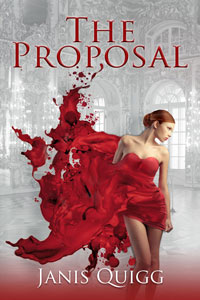Janis Quigg is not a designer, she’s an author who needed a book cover design. But like many authors she didn’t know where to start. So, she decided to take a stab at designing the book cover herself.
I received an email from Quigg asking me to critique her book cover design. (Now before you all groan and cover your eyes I want to assure you this book cover story has a very happy ending.)
“I’ve used your tutorials and template, and downloaded some sample stock images, but before I buy them, I wanted to ask if the cover I’ve designed looks too amateurish. This is still the rough draft. I still have to refine edges of the girl, composite her into the background, and line up the text…
… I know self publishing is all about branding and marketing, and the font I decide on now will be the font I use on all of my books.
Since this is my first release, I kind of feel like, the cover needs to be striking.”
Quigg was right in wanting a book cover that jumped off the page. The digital real estate for an author is very small. Bookshelves are crammed with hundreds of thousands of books all vying for the customers’ attention. Unfortunately, many self-designed covers look “self-designed” and amateurish.
Honestly, I fully expected an amateur design but was pleasantly surprised. Aside from a few minor adjustments, her initial design was very good – in fact it was striking – and that is what you shoot for – instant attention.
INTERVIEW with Janis Quigg
What were the trial and errors you had when starting your Book Cover adventure?
I didn’t have any trial and errors, because I just didn’t know where to begin. My first book had been edited and ready for a few weeks, but I almost pretended it wasn’t there, because I didn’t know what to do next. I was a little bit intimidated by cover design and eBook formatting. I needed someone to hold my hand, and it was a relief when I found First Steps Publishing.
How did you decide on the idea/design for your cover?
Basically, the first line of The Proposal is the front cover.
The orchestral sounds of “Moon River” greeted Maddy Reeves as she walked into the Grand Ballroom hoisting up the bodice of her crimson empire-line dress.
When I write, it’s almost like a mini movie plays in my mind’s eye, and I attempt to translate those images into words. With this cover, I attempted to change my words back into images.
How difficult was it to find the right image?
I had a very specific idea, and I did a Google search for a girl wearing a red dress. After a few ‘Woman Red Dress’ searches, I found her on Deposit Photos. The beauty of the image struck me, and I knew I had to use it.


You appear to have utilized two images for your design.
Yes, I wanted the girl to be in a ballroom, which meant I had to extract her from her image and composite her into the ballroom image. And, I wanted to change her hair color from blonde to red because of the following line.
Self-consciously, Maddy pulled up her bodice and tucked a stray strand of wavy auburn hair behind her ear. “You don’t think I look too Jessica Rabbit, do you?”
What image editing program did you use?
Photoshop. I am somewhat experienced, but more so with vector images and blog design. However, you don’t need to use Photoshop to create your book covers; there is a free alternative called GIMP GNU Image Manipulation Program). http://gimpshop.com/
How long did it take you to create the cover (from concept to completion)?
I had the concept, but no idea how to complete it. This is where Unruly Guides came into play. I searched for eBook cover templates and found a lot of conflicting information, but when I clicked on your blog, it was an instant a-ha moment. After buying How to Design eBook Covers and watching the video tutorials, it took me an afternoon to complete the rough draft. Once I had tweaked it, and let it sit overnight, it took about three hours to finish.
Any other tips or advice to give other authors on designing their book cover?
Look at your favorite authors on Amazon and see how their covers look in the thumb nail image. Can you make out the title and author name? Is the image too overpowering?
I looked at Nora Roberts’ books, and while my covers look nothing like hers, I noticed the font on all of her books is in small caps. As a result, I chose a small caps font on MyFont.com that will be used on all of my books.
The font I purchased is called Trajan Pro by Adobe. The blurb suggests: Trajan is an elegant typeface well-suited for display work in books, magazines, posters, and billboards.
As I mentioned, I had looked at the font on Nora Roberts’ book covers, and I loved the way the R of her surname curved beneath the O, and I decided I wanted something similar. So I searched My Fonts for small caps and tested my name against all of the fonts that came back. I narrowed it down to two, but decided on Trajan Pro because of how the Q curls beneath the U.
IMAGE SPECS:
- Stock Images: DepositPhotos.com
- Font: Trajan Pro from MyFonts.com
- Time from concept to completion: ~ 6 hours (research, layout, design)
Conclusion
Janis has a definite creative eye. But more importantly, she took the time to find the right image(s) and font for her book and was able to combine them to a nice effect. While many authors may not have the “creative eye” for creating the final book cover design, you can see that the preliminary research for the right image is. Then it is a matter of finding a designer who can turn your idea into a reality.
Quigg did her homework when designing a book cover. She…
- …researched how to design a book cover
- …used low resolution (free/comp) images before purchasing
- …asked for an evaluation of her design
- …she chose a pleasing font she could use throughout all her novels
The final outcome? Janis chose colors and a typeface that worked well together. Is it perfect? No. Is is striking and eye-catching? Yes. Will it sell more books? Perhaps. But it will grab attention, and that is the first step to a sale.
A Broken Design Rule: The only rule that is broken is the model is facing “off” the page. Normally this forces the eye “off” the page as well. However, since it is the blood that is the dominant element, it flows you from the title right into the woman. Very nice effect.
Steps to a Good Book Cover design
- Research competitors book covers. Detail the elements you like.
- Make a list of visual keywords from your book. In this case Janis took the first line of her book.
- Use quality, royalty-free, high-resolution images
- take more than 5 minutes to design your cover. Creativity can’t be achieved in a few minutes. The key is to be original, striking and attention grabbing.
Janis QUIGG
Visit Quigg on her website http://www.janisquigg.com or follow her on Twitter @janisquigg.

Designing the right cover may be too much for most authors.I think. It’s like doing surgery on yourself.if you’re inexperienced.